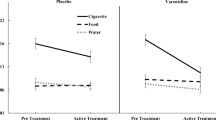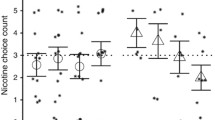Abstract
Rationale
Compared to men, the smoking behavior of women may be less responsive to nicotine and more responsive to nonpharmacological factors, perhaps including verbal information (e.g., dose instructions).
Objective
This study compared the influence of the presence vs absence of dose instructions on the subjective and reinforcing effects of nicotine via cigarette smoking in men and women.
Methods
Subjects (n=120) abstained overnight from smoking and were randomly assigned to one of four groups. Half of the subjects received nicotine cigarettes (Quest 1, yield of 0.6 mg), and the other half received denicotinized cigarettes (“denic”; Quest 3, yield of 0.05 mg). Furthermore, half of each subsample was accurately instructed they were receiving a “normal nicotine” or a “no nicotine” cigarette, while the other half received no instructions. Subjects completed baseline measures of craving and mood (positive and negative affect), took two puffs from the cigarette after receiving dose instructions or no instructions, and then rated the cigarette's “reward” value (liking, satisfying) and other characteristics. They also repeated the craving and mood measures. Subjects then smoked more of that same brand ad libitum over the next 30 min to measure reinforcement (puff number and latency to first puff).
Results
Overall, nicotine increased reward, other cigarette ratings, and positive affect, but did not affect craving or smoking behavior. However, results varied by sex. Dose instructions enhanced the effects of nicotine on smoking reward and reinforcement in women, while instructions tended to dampen or even reverse these effects of nicotine in men (i.e., interaction of sex×nicotine×instructions).
Conclusions
In women but not in men, the influence of nicotine on smoking reward and reinforcement is enhanced by accurate verbal information about the cigarette's nicotine dose. These results are consistent with the notion that the smoking behavior of women, relative to men, may be more responsive to nonpharmacological factors.



Similar content being viewed by others
References
Bradlyn AS, Young LD (1983) Parameters influencing the effectiveness of the balanced placebo design in alcohol research. In: Pohorecky LA, Brick J (eds) Stress and alcohol use. Elsevier Science, New York, pp 87–103
Brauer LH, Behm FM, Lane JD, Westman EC, Perkins C, Rose JE (2001) Individual differences in smoking reward from de-nicotinized cigarettes. Nicotine Tob Res 3:101–109
Carter BL, Tiffany ST (2001) The cue-availability paradigm: the effects of cigarette availability on cue reactivity in smokers. Exp Clin Psychopharmacol 9:183–190
Centers for Disease Control (CDC) (2003) Cigarette smoking behavior of adults: United States, 1997–98. Advance Data, no. 331
Chaudhri N, Caggiula AR, Donny EC, Booth S, Gharib MA, Craven LA, Allen SS, Sved AF, Perkins KA (2005) Sex differences in the contribution of nicotine and nonpharmacological stimuli to nicotine self-administration in rats. Psychopharmacology 180:258–266
Conklin CA, Perkins KA (2005) Subjective and reinforcing effects of smoking during negative mood induction. J Abnorm Psychol 114:153–164
Diener E, Emmons RA (1984) The independence of positive and negative affect. J Pers Soc Psychol 47:1105–1117
Fillmore M, Vogel-Sprott M (1992) Expected effect of caffeine on motor performance predicts the type of response to placebo. Psychopharmacology 106:209–214
Heatherton TF, Kozlowski LT, Frecker RC, Fagerstrom K-O (1991) The Fagerstrom Test for Nicotine Dependence: a revision of the Fagerstrom Tolerance Questionnaire. Br J Addict 86:1119–1127
Hughes JR, Gulliver SB, Amori G, Mireault GC, Fenwick JF (1989) Effect of instructions and nicotine on smoking cessation, withdrawal symptoms, and self-administration of nicotine gum. Psychopharmacology 99:486–491
Huitema BE (1980) Analysis of covariance and alternatives. Wiley, New York
Juliano LM, Brandon TH (2002) Effects of nicotine dose, instructional set, and outcome expectancies on the subjective effects of smoking in the presence of a stressor. J Abnorm Psychol 111:88–97
Kirsch I (1997) Specifying nonspecifics: psychological mechanisms of placebo effects. In: Harrington A (ed) The placebo effect: an interdisciplinary exploration. Harvard University Press, Cambridge MA, pp 166–186
Kirsch I, Rodino MJ (1993) Do double-blind studies with informed consent yield externally valid results? Psychopharmacology 110:437–442
Lukas SE, Sholar MB, Fortin M, Wines J, Mendelson JH (1996) Sex differences in plasma cocaine levels and subjective effects after acute cocaine administration in human volunteers. Psychopharmacology 125:346–354
Martin CS, Sayette MA (1993) Experimental design in alcohol administration research: limitations and alternatives in the manipulation of dosage-set. J Stud Alcohol 54:750–761
Mikalsen A, Bertelsen B, Flaten MA (2001) Effects of caffeine, caffeine-associated stimuli, and caffeine-related information on physiological and psychological arousal. Psychopharmacology 157:373–380
Nash JM, Holroyd KA, Rokicki LA, Kvaal S, Penzien DB (2002) The influence of placebo awareness on stimulant drug response in a double-blind trial. Psychopharmacology 161:213–221
Perkins KA (1996) Sex differences in nicotine versus non-nicotine reinforcement as determinants of tobacco smoking. Exp Clin Psychopharmacol 4:166–177
Perkins KA, Grobe JE, D'Amico D, Fonte C, Wilson A, Stiller RL (1996) Low-dose nicotine nasal spray use and effects during initial smoking cessation. Exp Clin Psychopharmacol 4:157–165
Perkins KA, Grobe JE, Caggiula AC (1997) Acute reinforcing effects of low-dose nicotine nasal spray in humans. Pharmacol Biochem Behav 56:235–241
Perkins KA, Donny E, Caggiula AR (1999) Sex differences in nicotine effects and self-administration: review of human and animal evidence. Nicotine Tob Res 1:301–315
Perkins KA, Gerlach D, Vender J, Grobe JE, Meeker J, Hutchison S (2001) Sex differences in the subjective and reinforcing effects of visual and olfactory cigarette smoke stimuli. Nicotine Tob Res 3:141–150
Perkins KA, Jacobs L, Sanders M, Caggiula A (2002) Sex differences in the subjective and reinforcing effects of cigarette nicotine dose. Psychopharmacology 163:194–201
Perkins KA, Sayette M, Conklin CA, Caggiula AR (2003) Placebo effects of tobacco smoking and other nicotine intake. Nicotine Tob Res 5:695–709
Perkins KA, Jacobs L, Ciccocioppo M, Conklin CA, Sayette M, Caggiula A (2004) The influence of instructions and nicotine dose on the subjective and reinforcing effects of smoking. Exp Clin Psychopharmacol 12:91–101
Robbins SJ, Ehrman RN, Childress AR, O'Brien CP (1999) Comparing levels of cocaine cue reactivity in male and female outpatients. Drug Alcohol Depend 53:223–230
Roberts TA, Pennebaker JW (1995) Gender differences in perceiving internal states: toward a his-and-hers model of perceptual cues. Adv Exp Soc Psychol 27:143–175
Rose JE, Behm FM, Westman EC, Bates JE, Salley A (2003) Pharmacologic and sensorimotor components of satiation in cigarette smoking. Pharmacol Biochem Behav 76:243–250
Tiffany ST, Drobes DJ (1991) The development and initial validation of a questionnaire of smoking urges. Br J Addict 86:1467–1476
Tremblay L, Elliott D, Starkes JL (2004) Gender differences in perception of self-orientation: software or hardware? Perception 33:329–337
Walach H, Schmidt S, Dirhold T, Nosch S (2002) The effects of a caffeine placebo and suggestion on blood pressure, heart rate, well-being and cognitive performance. Int J Psychophysiol 43:247–260
Westman EC, Behm FM, Rose JE (1996) Dissociating the nicotine and airway sensory effects of smoking. Pharmacol Biochem Behav 53:309–315
Acknowledgements
This research was supported by Grants DA12655 and DA16483 from the National Institute on Drug Abuse. The authors thank Carolyn Fonte for her helpful assistance.
Author information
Authors and Affiliations
Corresponding author
Rights and permissions
About this article
Cite this article
Perkins, K.A., Doyle, T., Ciccocioppo, M. et al. Sex differences in the influence of nicotine dose instructions on the reinforcing and self-reported rewarding effects of smoking. Psychopharmacology 184, 600–607 (2006). https://doi.org/10.1007/s00213-005-0103-7
Received:
Accepted:
Published:
Issue Date:
DOI: https://doi.org/10.1007/s00213-005-0103-7




